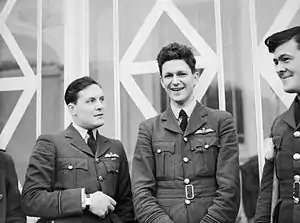James Brindley Nicolson
Wing Commander Eric James Brindley Nicolson, VC, DFC (29 April 1917 – 2 May 1945) was a fighter pilot in the Royal Air Force and a recipient of the Victoria Cross, the highest award for gallantry in the face of the enemy that can be awarded to British and Commonwealth forces.
Eric James Brindley Nicolson | |
|---|---|
 Flight Lieutenant Nicolson (centre) while recuperating from wounds after his VC action, November 1940 | |
| Born | 29 April 1917 Hampstead, London |
| Died | 2 May 1945 (aged 28) Bay of Bengal |
| Allegiance | United Kingdom |
| Service/ | Royal Air Force |
| Years of service | 1936–1945 |
| Rank | Wing commander |
| Service number | 39329 |
| Unit | No. 72 Squadron No. 249 Squadron |
| Commands held | No. 27 Squadron |
| Battles/wars | Second World War |
| Awards | Victoria Cross Distinguished Flying Cross |
Early life
Eric James Brindley Nicolson was born in Hampstead, London, on 29 April 1917, and was educated at Yardley Court and Tonbridge School. In 1935 Nicolson began working as an engineer, and in 1936 he joined the Royal Air Force, with the service number 39329.[1] After his training he joined No. 72 Squadron in 1937 and later moved to No. 249 Squadron in 1940.
Second World War
Nicolson was 23 years old and a flight lieutenant in No. 249 Squadron during the Second World War when he was awarded the Victoria Cross. On 16 August 1940 having taken off from RAF Boscombe Down near Southampton, Nicolson's Hawker Hurricane was fired on by a Messerschmitt Bf 110, injuring the pilot in one eye and one foot.[2] His engine was also damaged and the petrol tank set alight. As he struggled to leave the blazing machine he saw another Messerschmitt, and managing to get back into the bucket seat, pressed the firing button and continued firing until the enemy plane dived away to destruction.[2] Not until then did he bail out, and he was able to open his parachute in time to land safely in a field. On his descent, he was fired on by members of the Home Guard, who ignored his cry of being a RAF pilot.[2]
Victoria Cross citation
The announcement and accompanying citation for the decoration was published in supplement to the London Gazette on 15 November 1940, reading
Air Ministry, 15 November 1940.
The KING has been graciously pleased to confer the Victoria Cross on the undermentioned officer in recognition of most conspicuous bravery : —
Flight Lieutenant James Brindley NICOLSON (39329) — No. 249 Squadron.
During an engagement with the enemy near Southampton on 16th August 1940, Flight Lieutenant Nicolson's aircraft was hit by four cannon shells, two of which wounded him whilst another set fire to the gravity tank. When about to abandon his aircraft owing to flames in the cockpit he sighted an enemy fighter. This he attacked and shot down, although as a result of staying in his burning aircraft he sustained serious burns to his hands, face, neck and legs. Flight Lieutenant Nicolson has always displayed great enthusiasm for air fighting and this incident shows that he possesses courage and determination of a high order. By continuing to engage the enemy after he had been wounded and his aircraft set on fire, he displayed exceptional gallantry and disregard for the safety of his own life.[3]
Fully recovered by September 1941, Nicolson was posted to India in 1942. Between August 1943 and August 1944 he was a squadron leader and commanding officer of No. 27 Squadron, flying Bristol Beaufighters over Burma. During this time he was awarded the Distinguished Flying Cross.
As a wing commander, Nicolson was killed on 2 May 1945 when a RAF B-24 Liberator from No. 355 Squadron, in which he was flying as an observer, caught fire and crashed into the Bay of Bengal. His body was not recovered. He is commemorated on the Singapore Memorial.[4]
Nicolson was the only Battle of Britain pilot and the only pilot of RAF Fighter Command to be awarded the Victoria Cross during the Second World War. His Victoria Cross is displayed at the Royal Air Force Museum, Hendon, England.
Commemoration
.jpg.webp)
In 2015, the RAF repainted a modern Eurofighter Typhoon jet, ZK349, in Second World War colours, and applied Nicolson's squadron number, GN-A, to commemorate the 75th anniversary of the Battle of Britain.[5]
References
- Battle of Britain 1940.
- Bowyer, Chaz (2000). Fighter Pilots of the RAF 1939-1945. England: Pen and Sword. pp. 83–85. ISBN 9780850527865.
- "No. 34993". The London Gazette. 15 November 1940. p. 6569.
- "Casualty Details: Nicolson, James Brindley". Commonwealth War Graves Commission. Retrieved 9 January 2017.
- Farmer, Ben (21 May 2015). "Typhoon gets Battle of Britain VC hero's colours to celebrate 'The Few'". The Daily Telegraph. Retrieved 22 May 2015.
Further reading
- Mason, Peter D. Nicolson VC': the Full and Authorised Biography of James Brindley Nicolson, the only Pilot of Fighter Command in World War II to be awarded the Victoria Cross. Ashford, UK: Geerings, 1991. ISBN 0-9513042-9-1.
External links
| Wikimedia Commons has media related to James Brindley Nicolson. |
